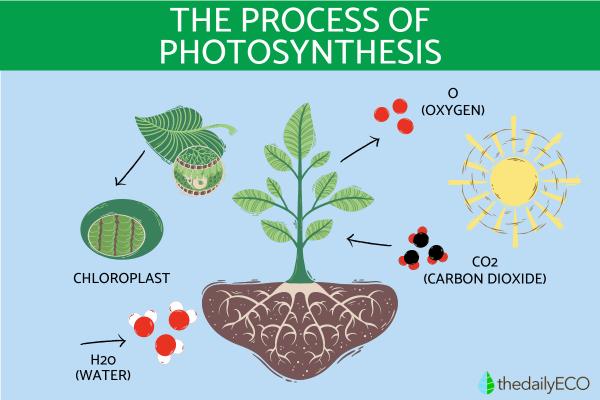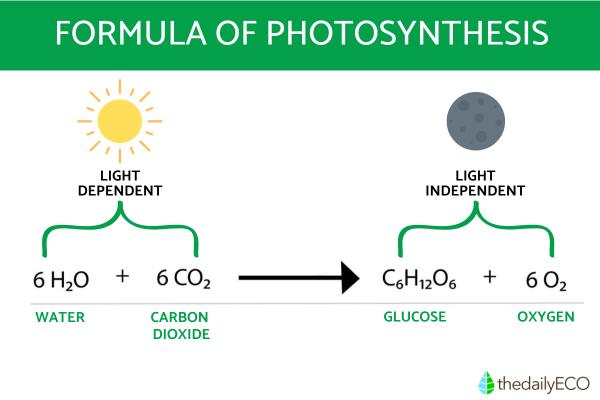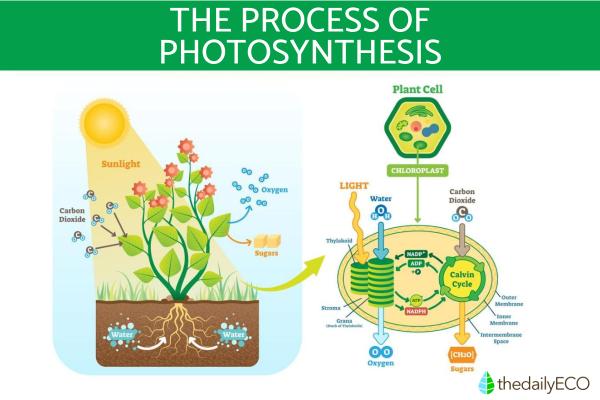
Photosynthesis is a fundamental process that allows plants, algae, and some bacteria to convert sunlight, carbon dioxide and water into organic matter and oxygen. This process is vital to the survival of many organisms on our planet, as it forms the basis of the food chain, provides oxygen for animals to breathe, and helps regulate the Earth's climate. However, despite its importance, many people are not familiar with the intricate details of photosynthesis.
The following article from thedailyECO we explain what photosynthesis is, how it works, and what role it plays in our ecosystem.
What is photosynthesis?
Photosynthesis is a remarkable process that enables plants, algae, and some bacteria to convert light energy into chemical energy in the form of glucose.
This unique ability distinguishes autotrophic organisms from heterotrophic organisms. Autotrophs, like plants, can produce their own food from simple inorganic substances, while heterotrophs, including animals and many microorganisms, must consume other organisms to obtain the nutrients they require.
Through the process of photosynthesis, plants and photosynthetic organisms are able to synthesize a range of organic compounds, including sugars, starches, cellulose, and proteins, which serve as the building blocks of their bodies. Additionally, photosynthesis is responsible for the release of oxygen, which is vital for the survival of most living organisms, as it is used in respiration to produce energy.
Chemical formula of photosynthesis
Photosynthesis can be expressed by a chemical formula common to all organisms that can perform this process. The formula for photosynthesis is:
6 H2O + 6 CO2 + light energy → C6H12O6 + 6 O2
This formula represents the basic steps of photosynthesis, which require six molecules of water (H2O), six molecules of carbon dioxide (CO2), and the input of light energy (photons).
Through the complex processes that occur in the chloroplasts of plant cells, these components are converted into one molecule of glucose (C6H12O6) and six molecules of oxygen (O2). The oxygen is released back into the atmosphere, while the glucose is used by the plant to produce energy and other important compounds such as proteins, starch, and lipids. Thus, the products of photosynthesis are glucose and oxygen.
This process is essential to the survival of plants and other photosynthetic organisms, providing them with the energy and nutrients they need to grow, reproduce and sustain life.

Phases of photosynthesis
Now that we have established what photosynthesis is and how it is chemically structured, let us turn our attention to the various phases of this important process.
Photosynthesis has two main stages:
- In the light-dependent stage, light energy is used to produce ATP and NADPH, which are energy-carrying molecules.
- In the light-independent stage, carbon dioxide is converted into organic molecules, such as glucose, using the energy stored in ATP and NADPH. This stage is also called carbon fixation.
In plant photosynthesis, which is the most common form, four main phases can be distinguished. However, the first three are referred to as light reactions, while this carbon fixation is light-independent and therefore referred to as dark reactions. This process is also known as the Calvin cycle.
Let us take a closer look at each of the stages:
- Absorption of light: the first phase of photosynthesis is absorption, in which plants take up water and minerals from their environment, usually through their roots.
- Electron transport: the absorbed light energy is used to excite electrons in the chlorophyll molecules, which are then passed down an electron transport chain, generating a proton gradient across the thylakoid membrane.
- ATP synthesis: this process involves moving electrons to a final acceptor, which results in ATP production. ATP is important because it provides the energy that plants need for their biological processes. This production of ATP only happens in the presence of light and is used only during the process of synthesis.
- Carbon fixation: during carbon fixation, plants take in carbon dioxide from the air and combine it with a molecule called RuBP. This process is helped by an enzyme called rubisco, which helps produce 3-PGA molecules. These molecules are then used in a series of chemical reactions to create other organic molecules like glucose. This requires energy from ATP and electrons from NADPH to happen. Overall, this process helps plants create the organic compounds they need to survive and grow.
Understanding the different phases of photosynthesis is essential to understanding the complexity and importance of this process for plant growth and survival, and therefore for all life on Earth.
You may be interested in this other article, where we explain what types of chlorophyll there are and what their function is.

Why is photosynthesis important?
Photosynthesis is a crucial process for our planet because it is responsible for the production of oxygen, which is essential for life. The first photosynthetic organisms played a crucial role in charging the atmosphere with oxygen, which led to the formation of the ozone layer. Without this protective layer, life on land would have been impossible due to the harmful effects of the sun's ultraviolet radiation.
While it is commonly believed that large forests and jungles are the main source of oxygen, the reality is quite different. The respiration of plants and the large amount of life they support means that their net oxygen supply is relatively small. Instead, the main source of oxygen production on Earth is in the ocean, where phytoplankton - consisting of unicellular algae and photosynthetic cyanobacteria - form the basis of the marine food chain and oxygen production.
These small autotrophic microorganisms are responsible for 50 to 85% of the oxygen currently produced on Earth, making them essential for life as we know it. Without them, we would have limited options for sustaining life and the diversity of life on our planet would be severely limited. Therefore, we must recognize and appreciate the importance of photosynthesis and the role of these microscopic organisms in sustaining life on Earth.
Do not miss the video below, where we explain in more detail the differences and characteristics of autotrophic and heterotrophic organisms.

If you want to read similar articles to How Does Photosynthesis Work?, we recommend you visit our Facts about nature category.